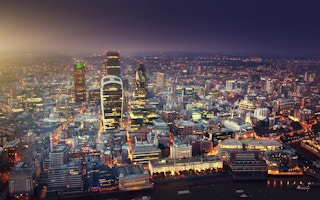Buildings today account for as much as a third of global greenhouse gas emissions, and the United Nations Environment Programme has stressed that the global community needs to tackle sustainability in the sector “with much greater seriousness and vigour than they have to date” to reduce its impact.
Coordinating such an effort to raise sustainability standards in buildings across the world is certainly a tall order - but Terri Wills, the newly-appointed chief executive of the World Green Building Council (WGBC), is stepping up to the challenge by focusing her efforts on forging partnerships between the private and public sector.
Wills, a Canadian who took the helm at WGBC this June, believes that these partnerships hold the key to driving change on a big scale. She now leads the non-profit organisation’s work with about 100 green building councils around the world – industry associations focused on driving sustainable building practices in their home countries – to provide the necessary resources and expertise they need.
“We have incredible members around the world,” she says. “Working together, they can achieve tremendous change.”
Before joining WGBC, Wills spent many years on making cities more sustainable; first as the London City Director for the Clinton Climate Initiative, where she worked with the Mayor of London’s office to support energy-saving building retrofits, and later in 2012, as Director of Global Initiatives at the C40 Cities Climate Leadership Group.
C40 is a network of 75 cities which share expertise and ideas on tackling climate change with each other. Under Wills’s leadership, the network’s activities had a direct impact on policies in over half of C40’s member cities, according to WGBC.
Now based in London, UK, Wills speaks to Eco-Business about her vision for WGBC in the coming years and why Asia presents a unique opportunity for innovation in the green building space.
At the upcoming International Green Building Conference (IGBC) 2015, Wills will be speaking on the role of green buildings in addressing climate change.
You have just taken the helm at WGBC from former CEO Jane Henley. What are your future plans for the organisation to accelerate the global green building movement?

Terri Wills, chief executive officer, World Green Building Council. Image: WGBC.
I plan to increase WGBC’s influence and impact to green all buildings so that we can reduce their carbon footprint and conserve natural resources, while also creating better lives for people, and a stronger economy.
For example, we will be ramping up our regional networks, which are platforms for collaboration among GBCs from the same region. We will draw lessons from the success of the European regional network, which was launched in 2010, consists of over 30 national GBCs, and collaborates with more than 4,500 member companies across Europe.
In March this year, the network launched ‘Build Upon’, which gathers stakeholders from multiple countries to help European countries design long-term strategies to improve the quality of their existing built environment.
We will also have a strong presence at the United Nations climate conference in Paris this December. A ‘Buildings Day’ will be held for the first time at the summit, and we will have more information available on this soon. WGBC is on the steering committee for this initiative, which is a wonderful opportunity to raise awareness on the potential of sustainable buildings not just among the public, but also among government leaders who can truly influence industry and policy on a large scale.
And finally, to help WGBC communicate its story better, and to the right audience, we are putting efforts into amplifying the successes of the network and of individual GBCS.
At the C40 Cities Climate Leadership Group, you led initiatives such as the C40 Networks. How will the perspectives and skills you developed at C40 shape your approach to leading a global green building movement?
“
The C40 networks facilitated cooperation and information exchange among city officials in several megacities, and in implementing these networks, we observed that the actions taken by the cities involved were bolder, more impactful, faster, and more resource-efficient if they worked together.
My work at C40 has provided valuable lessons. The C40 networks facilitated cooperation and information exchange among city officials in several megacities, and in implementing these networks, we observed that the actions taken by the cities involved were bolder, more impactful, faster, and more resource-efficient if they worked together. At WGBC, I will also be encouraging the same model of cooperation among GBCs and our partners so that we can accelerate our impact.
Just like C40, WGBC also has a global membership of green building councils. We need to focus on what these individual GBCs need in order to achieve significant impact in their countries, and then structure dialogues, cooperation, and programmes to deliver support in these areas.
At C40, how did you bring together private and public sector partners? What role do such partnerships play in the green building movement?
Recent research by C40 cities has shown that partnerships with the private sector are key to achieving climate action, especially as not all cities have the same amount of resources and power over aspects such as transport networks, land use planning, street cleaning, among others.
Private sector input is required in order to achieve real change within a shorter timeframe. Many businesses and organisations are starting to realise this, as evidence is mounting that sustainable buildings are not only environmentally and socially beneficial, they also make financial sense.
Making the private sector aware of these benefits – which go beyond just positive publicity – is a great strategy to get them involved. When sustainable construction makes good business sense, then there is no reason not to come on board.
To this end, our new campaign, Better Places for People, raises awareness of the positive impact of green buildings on the health and well-being of employees. Private sector partners for this initiative include French construction and materials giant Saint-Gobain, Australian property multinational Lendlease, and British retailers Marks and Spencer.
What are some challenges and opportunities you foresee in getting the building sector in Asia Pacific to adopt more sustainable practices?
“
Buildings currently are responsible for 30 per cent of global carbon emissions, and this could double or triple by 2050 if nothing is done to mitigate emissions. The world must reduce its emissions significantly by 2050, and green buildings can help us get there.
Many of our most active and fast-growing GBCs are located in the region, and our Asia Pacific Network is growing stronger and becoming a powerful source for collective action.
There is also tremendous opportunity to innovate with new, green buildings in Asia, unlike in the US and Europe where the focus is more on retrofitting existing structures. In India, for example, two-thirds of buildings that will exist in 2030 are yet to be built, while 80 per cent of the buildings we have in London today will still exist in 2050.
Local and national policies also support the green building movement in Asia. The high calibre of entries in our 2014 Asia Pacific Leadership Awards, which celebrate best practices in green buildings, attest to this. The right policies and incentives for green buildings will be instrumental in encouraging green building practices in the region.
Some challenges that Asia Pacific faces include a high population density and high rates of urbanisation. Because of these unique challenges, Asian countries may not always be able to draw on green building lessons learnt by other nations. Innovating new techniques will be key to maximising Asia’s green building potential, and many of our GBCs are at the forefront of this.
Asia’s demographic and resource challenges are precisely what make green buildings a necessity for the region, not a luxury. I therefore think the region will see a very high uptake of sustainable building practices in years ahead.
In your work with cities and building industry leaders across the world, what are some of the best practices you have seen to promote climate action?
One example of good leadership is when former Mayor of London Ken Livingstone announced at a C40 Mayors Summit in 2007 that he would retrofit 100 London-owned and operated buildings to be more energy efficient. The outcome of this was the RE:FIT initiative, which provides administration and funding support to public sector buildings in London to carry out energy efficiency retrofits.
In Japan, Tokyo has implemented a Cap and Trade programme, a mandatory emissions trading scheme which made it compulsory for buildings with high carbon emissions to reduce energy usage. This programme was first enforced from 2010 to 2014, and again from 2015 to 2019.
During the first compliance period, more than 70 per cent of buildings already met the 2019 reduction target, reducing energy usage by 23 per cent from base-year emissions. This scheme has demonstrated that long-term policy can drive action in the private sector.
Another success area is in the finance industry. In Australia, for example, the Sustainable Melbourne Fund – an initiative by the Melbourne City Council – and the State of Victoria offer ‘Environmental Upgrade Agreements’. Under this scheme, banks provide an upfront sum to building owners wanting to upgrade their property. Repayments on this loan are collected by local government through a mechanism similar to council taxes, which are then passed on to the financial institution. This arrangement gives banks the security to provide better terms, and tenants can also use their energy savings to repay the loans.
Ahead of the landmark climate conference in Paris at the end of the year, what are your expectations from the agreement, and how do you think cities and buildings can contribute towards mitigating and adapting to climate change?
Professor Jeffrey Sachs recently said “We have six months to save the world”. I feel it is vital that this event establishes a global consensus that humans are responsible for climate change, that we must reduce emissions sufficiently to stay within a temperature increase of two degrees. This is entirely possible with leadership, ambition and collaboration.
The inclusion for the first time of a Buildings Day at the summit is both an exciting opportunity and a grave responsibility. We must make governments aware of the potential that green buildings have to address climate issues. Buildings currently are responsible for 30 per cent of global carbon emissions, and this could double or triple by 2050 if nothing is done to mitigate emissions. The world must reduce its emissions significantly by 2050, and green buildings can help us get there.


















